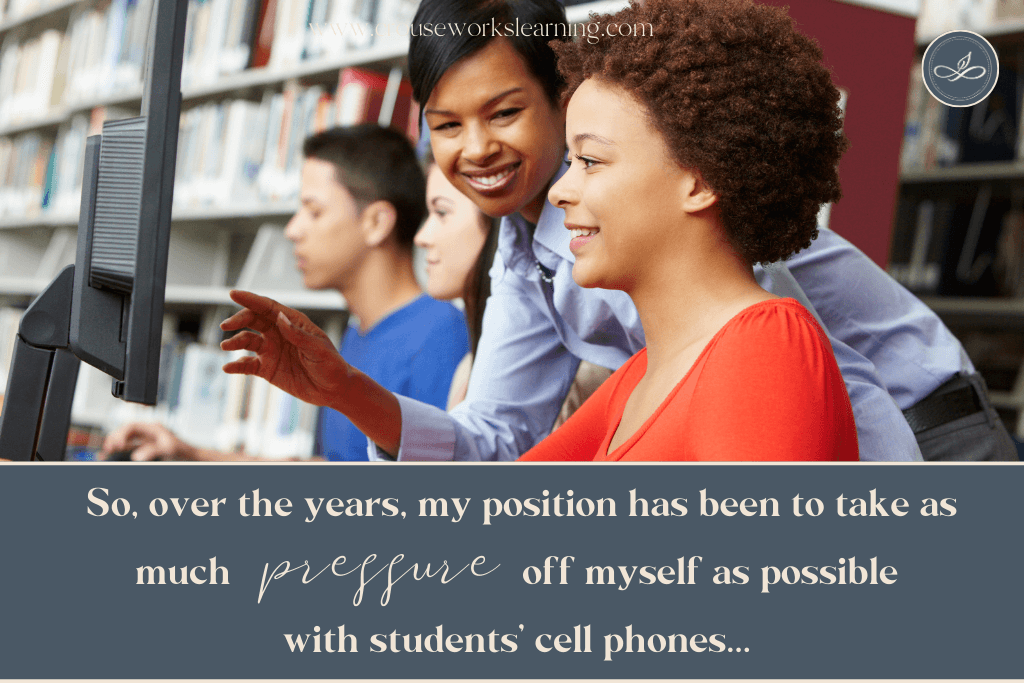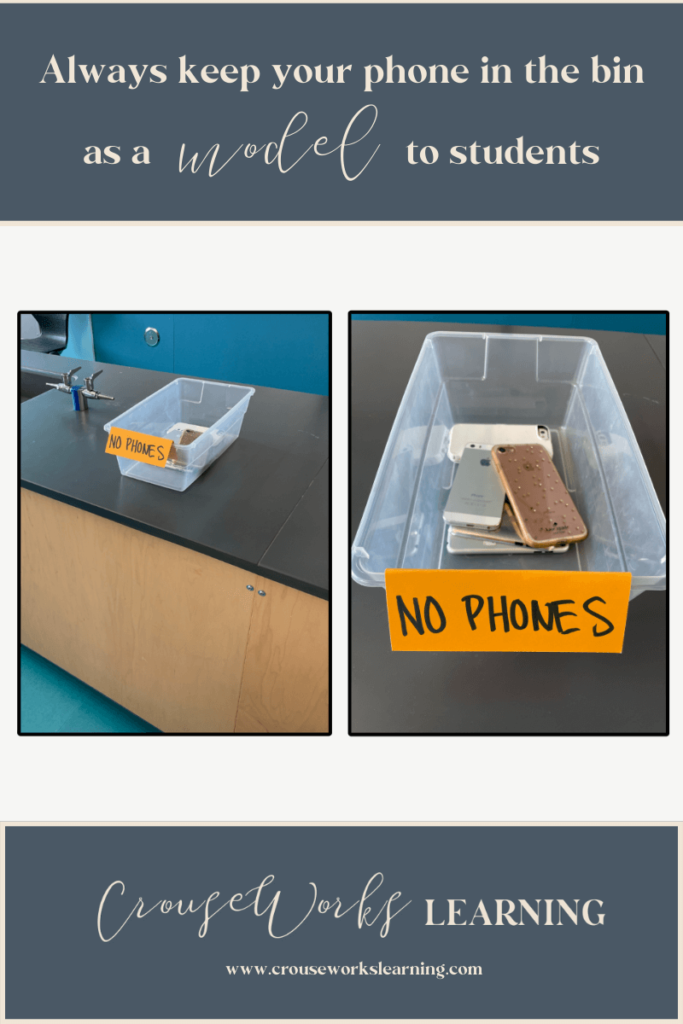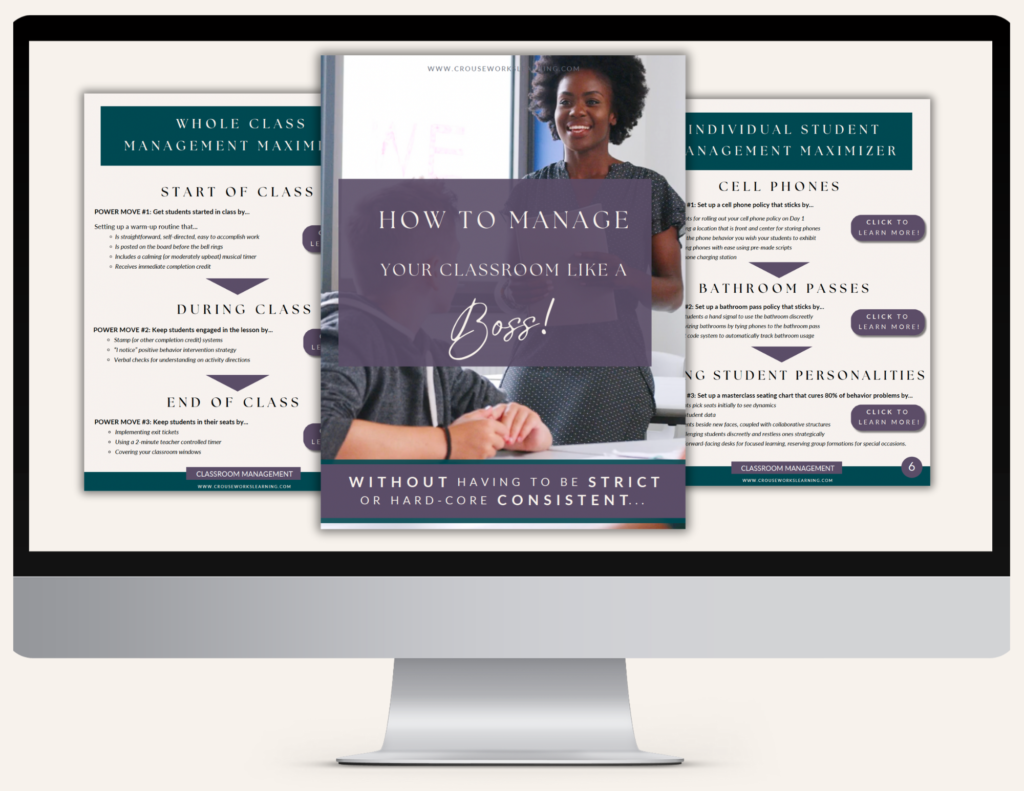Cell phones. Ahhhhhh…. where do I begin??
Such a valuable tool in so many ways, yet the bane of existence for so many teachers.
I don’t know about you, but for me, cell phones have always been a war of attrition in the classroom. I always start off the year with very strong expectations. I make it very clear that I have zero tolerance for using cell phones in class (except for those rare family emergencies). And usually, for the first couple of days of school, I’m pretty good at confiscating phones.
However, after the first week, I begin to fall off the wagon. Confiscating cell phones quickly becomes a major chore. Not only does it take time away from instruction, but you never know if you’ll end up in a confrontation with a student (and that’s just anxiety-inducing). It leads to a lot of highly charged socio-emotional interactions, and you just don’t have the energy to continuously take that on as a teacher.

So, over the years, my position has been to take as much pressure off myself as possible with students’ cell phones.
Now, before I dive into my strategies for doing that, I want to first share how I roll out my cell phone policy at the beginning of the year. And I want to do this for two reasons:
- (1) I have generally found that students are much more amenable to cell phone policies when they understand the bigger picture. Which means the strategies below won’t work unless students understand the “why” behind your cell phone policy.
- (2) When I first started as a teacher, I wished so badly to have verbatim scripts of what to say with tricky topics like cell phones. So my hope is that, if you are a new teacher, you feel free to use the script below as a guide should it be useful 😉
So, here’s the speech about cell phones that I usually give to students during the first week back at school:
"In my years of teaching, I've come to find that cell phones are helpful in many ways- but in the classroom, they tend to set students back. So, in this classroom, cell phones will never need to be out, not just for your sake but for the students around you as well. Because being on your cell phone distracts the other people around you as much as it does you. Now, I will never ask something of you that I am unwilling to do myself first, so you see, my cell phone is in this bin. You will never see me on it during class. Because when I am teaching, I am here. I am present with you, and I'm going to give you my all. And because of that, I expect the same back from you. So, if I see you with your cell phone out, I will ask you to place it in the bin alongside mine for the remainder of the class. Please know I'm not a teacher who gives repeated warnings or second, third, or fourth chances. You are practically adults, and you now know my expectations on cell phones, so I expect there won't be a problem moving forward."

Now, I’ll admit, students will undoubtedly nod when they hear your cell phone policy. And, in the moment, they will genuinely appreciate the heartfelt reasoning behind the policy.
However… It’s important to note… that sweet connection that you’ve just established with them will not last… and students will inevitably forget what you’ve said within 10 minutes.
And, you know what? That’s okay! Because you’ve laid the foundation. And you can always remind students about “your why” regarding cell phones throughout the year.
Not to mention, I do have compassion for students. I mean… it is hard enough for us teachers to stay off our phones during a 1-hour faculty meeting… So how much harder can it be for our students, who struggle with hormone overload, to keep off their favorite apps for 7 tedious hours of classes?
So, all that to say, as great as your start-of-year speech is, you DO need a plan in place around cell phones… so let’s talk about one!
TIP #1: You have permission to have fun with your cell phone policy
Now that I’ve given my policy rollout speech, the next thing I do is place the bin in the front of the class room (visible to all) with a label that reads “no phones.” Next, I put my cell phone in the bin (modeling for students the behavior I wish for them to exhibit). Usually, I keep the bin front and center in the class. Occasionally, though, I’ll walk around with it to remind students that the bin is still around and that I’m keeping my eyes peeled.
I always have fun with this though and joke, “My cell phone is lonely. It’s looking for its new best friend!” or “Gotta catch ’em all!” My students also find this funny and will joke, “Watch out! She’s on the prowl!”
It’s important for students (and for you) to have fun with your cell phone policy.
At the end of the day, cell phones are just one more shiny “toy” for students. It’s nothing personal. And the more we can “de-signify” the phone issue, the happier we will be as teachers.

TIP #2: What to say when you DO have to confiscate a cell phone
Now, inevitably, there will come a point when you need to confiscate a student’s phone. This is never fun. But here’s my best tips and tricks for when that happens:
First, it is important to stand firm.
The student will beg and plead with you not to confiscate their phone. They will be full of “Yeah, buts” and “I wasn’t on it…” and “It was my mother texting me…” and “Wait, I promise I’ll put it away!” and “Here see, I’m putting it away in my backpack right now!”
Over time, as a high school teacher, I’ve come to accept a hard truth about teenagers. Teenagers are truly sweet, well-intentioned creatures at heart but are absolutely terrible when it comes to self-control and follow-through.
No matter how much students plead with you or make compromises about putting their phones away, they cannot keep up their end of the deal. They just won’t be able to. Therefore, it is much easier in the long run to follow through with what you say and not let students talk you out of it. Just confiscate the phone. Will be temporarily upset? Yes. Will they pout? Yes. But I promise you, they will also let it go within minutes. Especially if you do the following…
- Let them know they will get it back at the end of class.
- Let them know the cell phone will stay safely in the phone bin
I want to make a quick disclaimer, though. Throughout this process, it is important to me never to lay a hand on students’ phones. It always goes much better if you allow students to place their own phones in the bin.
In fact, for students who are really struggling to let their phones go, I will sometimes just leave the bin in front of them, walk away for a couple of minutes, and then come back once they’ve placed their phone in the bin. It’s helpful to give teenagers space like that sometimes.
Lastly, be prepared for students to try and compromise with you until the last second. They will throw last-minute things at you, saying things like, “Can I at least charge it at the front of the classroom?”
To that, I say to students, “My policy is that the phone must be placed in the bin for the rest of the period (whether that’s 30 minutes or 5 minutes), and I must be able to walk around with the bin as needed.” So if the student is that desperate to charge their phone- I will let them plug it into a Chromebook and put the Chromebook and cell phone into the bin. However, I will not allow the student to plug their cell phone into the wall and then place it in the bin, thus confining the bin to the wall outlet. And that is because, as we all know, when you allow that student to do that, even if it’s just for one time, you inevitably must allow every other student (for the rest of the year) to do the same thing. Which will become a problem later on when you need to walk around the classroom with the bin or need to be able to place the bin in front of another student.

Second, it’s important to give students a choice.
If you end up in a wrestling match with a student about their phone, remember cell phones are not the hill to die on. When you encounter a student unwilling to give up their cell phone, your best course of action is to give them a choice and then let it go.
I usually say to students one of the following,
- “You’ve got 2 choices- you can either put your cell phone in the bin now and get it back at the end of class, or I’ll ask the dean to confiscate it from you later in the day, and you’ll get it back when school is over. I’ll give you a minute to decide, and then I’ll return.”
- Or “You’ve got 2 choices- you can put your phone in the bin now and get it back at the end of class, or I can reach out to your parents at the end of the day about appropriate cell phone usage in my classroom. I’ll give you a minute to decide, and then I’ll return.”
When you give students choices, it is empowering to them (at least slightly), and they’ll be more bought in. Granted, you need to make sure the 2 choices you give them are choices you can live with as a teacher and choices that you can follow up with.
An alternative approach you can also use is the rule of 3. If I ever want students to follow direct instruction, I’ve found I will get more buy-in if I deliver the instruction in 3-piece bites.
For example, “Class… Please stand up, push in your chair, and walk over to me now.” That gets much more buy-in than saying, “Class, please walk over to me now.” For whatever reason, students are much more willing to follow directions when they are grouped into 3s.
So, for example, with the cell phone, you could say, “I’ll be back in a minute and in the meantime I need you to… silence your phone, turn it face down, and place it in the bin.” That is much more effective than “I’ll be back in a minute and in the meantime I need you to… place your phone in the bin.”
TIP #3: Phone Charging Stations (hit or miss?)
The only other strategy I’ve seen decent potential in is charging stations. I’ve never had much luck with large pocket phone holders or cabinets. But I believe charging stations do have potential. If you are unaware of this strategy, some teachers will purchase cell phone charging stations for their classrooms (like this) or huge power strips (like this).
Teachers use these charging stations to incentivize students to place their phones on the charger (at the beginning of class) rather than keep them on their person.
What you end up running into, however, is that students will want to routinely stand up and walk across class to check their phones, or the phones will keep pinging notifications.

I’ve never tried using a charging station, but if I were to try one out, I would use it to replace my “phone bin” and only allow students whose phones I confiscated to plug their phones into the charging station. I would likely hide the charging station in the corner and in a large cardboard box so students would not be tempted to look over and stare longingly at their phones. It would also be imperative to make it clear to the students that their phones had to be placed on silent before going on the charging station, and students would not be allowed to touch their phones again until class was over.
Now, you might say, “But won’t students then purposely get their phones out just to have them charge on the station?” Or you might be wondering, “But aren’t you just rewarding bad behavior by only letting students who have their phones out put them on the charging station?”
My answer to the first is, “Sure, you bet they’ll try to do that. And truthfully, that’s fine with me. Because the caveat is the moment their phone is on that charging station, they are not allowed to touch it (or see it) for the rest of class. So if they’re alright with that, then I am too. Additionally, most kids use Chromebooks to charge their phones anyway nowadays. So a charging station is not as big an incentive as one might think.”
And to the second question, “Yes, it’s not the most ideal system in the world. But if it works, keeps me sane, and allows me to enjoy teaching longer, I’ll do it. Sometimes, you just have to compromise on small things like that in the overall grand scheme of teaching.”
To wrap up
In education, navigating cell phone policies is no small feat. There is no one-size-fits-all policy on cell phone usage. Please know you are not crazy- cell phones are tricky for EVERY teacher. And for better or worse, the buzzing, beeping, and pinging of the digital age is not going away any time soon.
But I hope you’ve found some comfort in reading this post and knowing you are not alone as a teacher. I also hope you’ve found some practical tips to manage cell phone usage in your classroom!

P.S. If you’d like to see even MORE classroom management teacher hacks for the rest of your lesson, download my FREE “How to Manage Your Classroom Like a Boss” guidebook.
It’s an all-in-one guidebook that walks you through my best-kept strategies for getting students to start working at the bell, maintaining that momentum during class, and keeping your students working to the very last minute of class.
And the best news of all is it’s FREE! So download the guidebook now!

